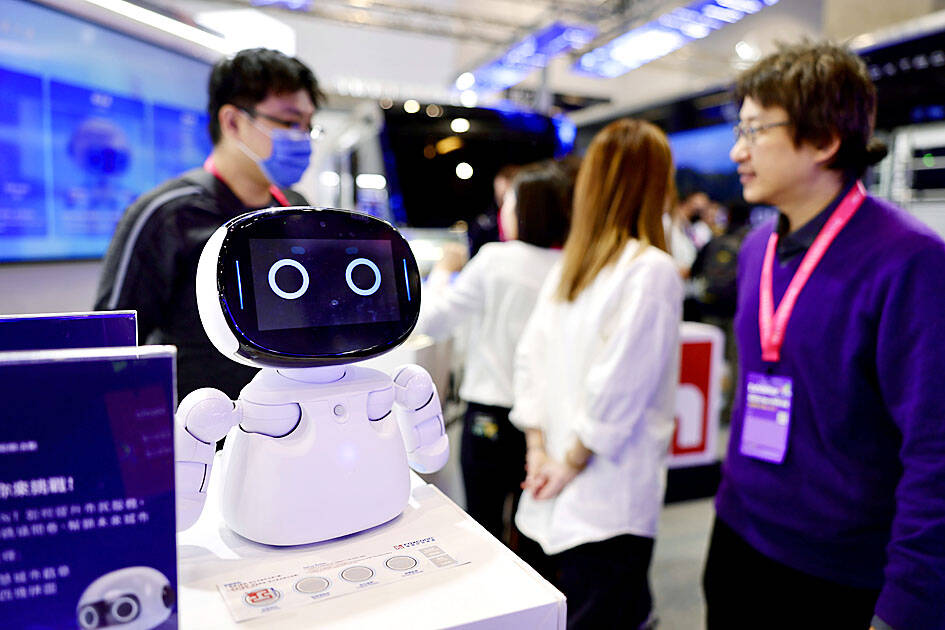Taiwan is to launch a five-year plan to boost the robotics industry in a bid to address labor shortages stemming from a declining and aging population, the Executive Yuan said yesterday.
The government approved the initiative, dubbed the Smart Robotics Industry Promotion Plan, via executive order, senior officials told a post-Cabinet meeting news conference in Taipei.
Taiwan’s population decline would strain the economy and the nation’s ability to care for vulnerable and elderly people, said Peter Hong (洪樂文), who heads the National Science and Technology Council’s (NSTC) Department of Engineering and Technologies.

Photo: Ritchie B. Tongo, EPA-EFE
Projections show that the proportion of Taiwanese 65 or older would exceed 20 percent by the end of this year, continuing the decline in the size of the nation’s workforce, Hong said.
Robotics is the most promising answer to the looming labor shortage that would negatively affect the economy, the long-term care system and the government’s capability to conduct high-risk operations during national contingencies, he said.
Any policy aiming to stimulate robotics development must provide comprehensive support for industries that make up the sector, including artificial intelligence, advanced chip manufacturing, sensors, material science, edge computing and mechanical design, he said.
The Cabinet’s smart robotics policy would emphasize Taiwan’s fully developed supply chains in the information and communications technology, and precision manufacturing industries, and its capability for integrating technologies from disparate fields, Hong said.
Under the initiative, the council would direct NT$10 billion (US$331.25 million) of subsidies to start-ups involved in robotics research-and-development over four years, he said.
That component of the program is to draw funds from government-run industry parks, the Forward-looking Infrastructure Development Program and private enterprises, Hong said.
The plan would include measures aimed at increasing the value of robotics companies catering to the service sector to NT$50 billion from NT$4 billion in five years, officials said.
The NSTC and the Ministry of Economic Affairs are to fund tech and robotics industry parks in Tainan’s Shalun (沙崙) and Lioujia (六甲) districts to join a manufacturing center being expanded in Liouying District (柳營), Hong said.
The three industrial parks would form a tech industry corridor in Taiwan’s south, he said.
Taiwan’s robotics industry lags behind that of its competitors, despite the nation’s leadership in advanced semiconductors and information technology, Cabinet spokeswoman Michelle Lee (李慧芝) said.
This shortcoming must be overcome to ensure that Taiwan remains competitive in the global economy, protect national cybersecurity and meet society’s needs, Lee said.
NSTC Deputy Minister Chen Bing-yu (陳炳宇) said that Taiwan can close its capability gap in robotics by integrating upstream enterprises with domestic part manufacturers already in play.
On Wednesday, NSTC Minister Wu Cheng-wen (吳誠文) said the nation’s drive to jump-start a robotics industry would prioritize technology that can be applied to the healthcare, restaurant and hospitality sectors.
The government’s aim is to have Taiwanese-made robots in the sectors hit the market within two years, Wu said.

The Central Weather Administration (CWA) yesterday said it expected to issue a sea warning for Typhoon Fung-Wong tomorrow, which it said would possibly make landfall near central Taiwan. As of 2am yesterday, Fung-Wong was about 1,760km southeast of Oluanpi (鵝鑾鼻), Taiwan’s southernmost point, moving west-northwest at 26kph. It is forecast to reach Luzon in the northern Philippines by tomorrow, the CWA said. After entering the South China Sea, Typhoon Fung-Wong is likely to turn northward toward Taiwan, CWA forecaster Chang Chun-yao (張峻堯) said, adding that it would likely make landfall near central Taiwan. The CWA expects to issue a land

Taiwan’s exports soared to an all-time high of US$61.8 billion last month, surging 49.7 percent from a year earlier, as the global frenzy for artificial intelligence (AI) applications and new consumer electronics powered shipments of high-tech goods, the Ministry of Finance said yesterday. It was the first time exports had exceeded the US$60 billion mark, fueled by the global boom in AI development that has significantly boosted Taiwanese companies across the international supply chain, Department of Statistics Director-General Beatrice Tsai (蔡美娜) told a media briefing. “There is a consensus among major AI players that the upcycle is still in its early stage,”

The Central Weather Administration (CWA) yesterday said it is expected to issue a sea warning for Typhoon Fung-wong this afternoon and a land warning tomorrow. As of 1pm, the storm was about 1,070km southeast of Oluanpi (鵝鑾鼻), Taiwan’s southernmost point, and was moving west-northwest at 28 to 32kph, according to CWA data. The storm had a radius of 250km, with maximum sustained winds of 173kph and gusts reaching 209kph, the CWA added. The storm is forecast to pass near Luzon in the Philippines before entering the South China Sea and potentially turning northward toward Taiwan, the CWA said. CWA forecaster Chang Chun-yao (張峻堯) said

Japanese Prime Minister Sanae Takaichi yesterday said that China using armed force against Taiwan could constitute a "survival-threatening situation" for Japan, allowing the country to mobilize the Japanese armed forces under its security laws. Takaichi made the remarks during a parliamentary session while responding to a question about whether a "Taiwan contingency" involving a Chinese naval blockade would qualify as a "survival-threatening situation" for Japan, according to a report by Japan’s Asahi Shimbun. "If warships are used and other armed actions are involved, I believe this could constitute a survival-threatening situation," Takaichi was quoted as saying in the report. Under Japan’s security legislation,